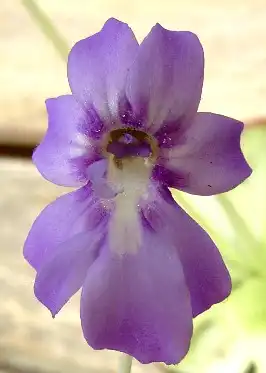Pinguicula moranensis from ‘Molango’
TaxonomyPermalink
- Family: Lentibulariaceae
- Genus: Pinguicula
- Name: not yet published
- Sub-classification (Casper): link
- Publication: no publication
DescriptionPermalink
- soon -
Origin and HistoryPermalink
Location / MapPermalink
From Molango (state of Hidalgo) ?
(click on the map for better location and relief map)
HabitatPermalink
Introduction to HorticulturePermalink
My plant was obtained from the collection of Loyd Wix (GB).
Growth and PropagationPermalink
(North hemisphere, France near Paris, in a polycarbonate greenhouse - see the map
Life CyclePermalink
The life cycle observed in culture for this Pinguicula consists of two seasons, one wet and the other dry (see link). The plant forms different leaf rosettes according to the season. During the resting months (winter) the small succulent rosette is composed of numerous non-carnivorous leaves. The carnivorous leaves are produced in spring and during all summer. The life cycle of the plant is probably similar in it’s native habitat.
MediaPermalink
I use a 100 % mineral media : 2 perlite, 2 vermiculite, 1 small sand (for aquarium), 1 fine white sand, 1 pouzzolane (volcanic lava), 1 aqualit (expansed ceramic for aquarium). The aqualit can be replaced by 1 of pouzzolane. Plants in this media grow slower but have a stronger root system.
PotPermalink
Plastic, colour terracotta, diameter 12.5cm, height 12cm.
CultivationPermalink
I think that a slightly airy situation inside the greenhouse is important to avoid air stagnation. For this reason, I use a fan 24h/24h all the year round.
Watering is very important : from May to September (summer). I let the media drying slightly between two watering. I use rain water poured on the top of the pot taking care not to wet the rosette. From October to April, It is important to let the media drying completely (no watering) but with an atmospheric humidity of about 80%.
The mentioned months are indicative and can change according to your own growing conditions. In fact, when this Pinguicula begins to produce its non-carnivorous leaves, you have to stop watering and let the pot drying out completely. Inversely, when the plant begins to produce in early spring its carnivorous leaves, you have to progressively start watering again the pot.
TemperaturePermalink
During growth period, day temperatures are about 25°C but may reach 35°C when the sun is shining on the greenhouse in spite of the use of shading covers. Night temperatures are around 20°C. During resting period: day/night ~~~~ over freezing point. Lower temperature observed : - 4°C. I use an electronic petroleum heater to provide heat.
Flowering PeriodPermalink
June 01; September 02.
PropagationPermalink
I have never succeeded up to now in pollinating the flowers of this Pinguicula. So I don’t know how the seeds look like. The plants can be propagated easily using non-carnivorous leaves separated from the rosette at the end of winter. You only have to carefully tear out the totality of the leaf particularly with it’s white base as the new plantlets will sprout from this area. Don’t try with the summer leaves, it is harder.
PicturesPermalink
|
Pinguicula moranensis from Molango Photo : Eric Partrat (september 2002) |
The flower of Pinguicula moranensis from Molango Photo : Eric Partrat (september 2002) |
A strange-looking flower with multiple/divided lobes on a P. moranensis 'Molango'. None of the other flowers on the plant show this feature. See some other strange looking plants in the "Bizarre Gallery". Photo : Vic Brown - June 2003 - |
|
|
Landscape of the Sierra Alta of the State of Hidalgo in the surroundings of Molango. Where this Pinguicula have been collected ? Photo : Dr. Manuel Aguilar This image in its original context, on the page : |
View of the town of Molango in the Sierra Alta of the State of Hidalgo. Where this Pinguicula have been collected ? Photo : Dr. Manuel Aguilar This image in its original context, on the page : |

.webp)
.webp)

.webp)
.webp)